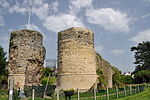Earsham railway station
Disused railway stations in NorfolkFormer Great Eastern Railway stationsPages with no open date in Infobox stationRailway stations in Great Britain closed in 1916Railway stations in Great Britain closed in 1953 ... and 3 more
Railway stations in Great Britain opened in 1860Railway stations in Great Britain opened in 1919Use British English from January 2018

Earsham was a railway station in Earsham, Norfolk, England. It was located on the Waveney Valley Line which connected Beccles with the Great Eastern Main Line. It opened in 1860 and closed to passengers in 1953, and to goods services in 1960. The station building was not demolished, but lay derelict for many years before being converted into a house. The platform also remains.
Excerpt from the Wikipedia article Earsham railway station (License: CC BY-SA 3.0, Authors, Images).Earsham railway station
Station Road, South Norfolk Earsham
Geographical coordinates (GPS) Address Nearby Places Show on map
Geographical coordinates (GPS)
| Latitude | Longitude |
|---|---|
| N 52.451 ° | E 1.4141 ° |
Address
Station Road
Station Road
NR35 2TT South Norfolk, Earsham
England, United Kingdom
Open on Google Maps











